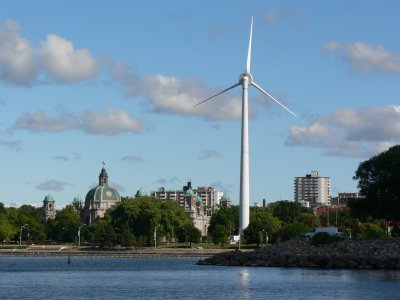Author: Alicia Webb

The Toronto urban turbine project is the first wind turbine in North America to be built in an urban setting. In addition, it was Ontario's first ever community owned wind project. These days it stands tall over downtown Toronto — an ever present reminder of what communities can achieve when working together.
Project overview
The Toronto urban turbine was built as a partnership between the municipal utility, Toronto Hydro, and the Toronto Renewable Energy Co-operative (TREC). TREC is a non-profit which formed an incorporated subsidiary called WindShare, a for-profit group of 425 community investors. The turbine is located in the Exhibition Place, a major trade centre on the waterfront, just 4 kms south west of central downtown Toronto. It is a single, 660 kW Lagerwey LW52 direct drive turbine with a 65 m hub height and a 52 m blade diameter. It was erected on December 18, 2002.
Project cost and funding
The project cost was $1.6 million CAD including project development and installation.The WindShare Co-operative and Toronto Hydro Energy Services co-own the turbine under a joint venture agreement. Revenue as well as operation and maintenance costs are shared 50/50.
Four months after the WindShare offer was launched, 427 members had invested an average amount of $2000 each in support of the project. By the second day of turbine construction, WindShare membership was fully subscribed and the $800,000 capital investment target
had been reached.
Background
The Toronto Renewable Energy Co-operative (TREC) received a grant in 1999 to investigate three potential sites for the project. They also began a community engagement program and held public information meetings in community centres, church halls and other locations in Greater Toronto.
Challenges
Installing a wind turbine in downtown Toronto was a groundbreaking effort, despite the fact that there are examples of commercial wind turbines in urban areas in northern Europe (especially in Denmark, Germany, and the Netherlands).
Usual wind turbine planning issues such as environmental impact, noise assessments and visual impact assessments were intensified by the turbine's proximity to inhabited places. It can be seen by most of downtown Toronto and overlooks a major expressway.
Results
The turbine generates an average of 1,000 megawatt hours of power per year, equivalent to the electricity needs of over 200 homes.The project also resulted in the development of local skills and employment. Almost all of the turbine parts, including the tower and blades, were manufactured in Ontario. The transformer at the base of the turbine and the nacelle were manufactured in the Netherlands.
In addition, WindShare co-operative were able to provide tools, templates and other services to assist other groups to form community wind co-ops. The project also initiated the creation of TREC’s renewable energy education program including tours and excursions, workshops, festivals and fairs and a green collar career program.
More information
-
The original Offer Statement for WindShare membership (see attachment below)
-
The WindShare website
-
The TREC website
-
The Lagerwey Wind website